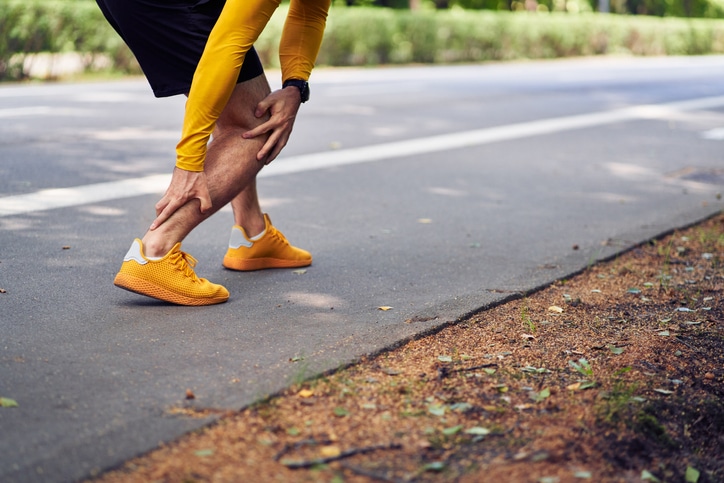If you’re a sports fan, you might think a torn Achilles tendon is an injury only athletes need to worry about, but that’s not the case.
“It typically happens to someone who’s middle-aged, whether they’re active or just happen to do something that puts them at risk,” says Mirian Okoye, MD, family and sports medicine physician on the medical staff at Methodist Richardson Medical Center.
The Achilles is a strong fibrous cord that connects the muscles in the back of your calf to your heel bone. It can tear or rupture when overstretched, whether during athletics or exercise or simply by taking a misstep.
Men in their 30s, 40s, and 50s are more likely to suffer such an injury because of trauma or wear and tear on the tendon that naturally comes with age. Women can also be at risk, especially if they frequently wear heels, which puts stress on the tendon.
“The Achilles tendon becomes shorter and stiffer when wearing high heels regularly,” Dr. Okoye says. “The higher and narrower the heel, the more stress it causes.”
The good news, for athletes and average Joes alike, is that Achilles strains and ruptures can now be treated with minimally invasive techniques that allow the injury to heal quicker.
“There are minimally invasive options that patients can discuss with their orthopedic surgeon to determine which approach best suits them,” Dr. Okoye says.

HOW TO SPOT IT
Among the general public, approximately five to 10 people per 100,000 suffer Achilles tears each year, and over 80 percent of those ruptures occur during recreational sports, according to a 2023 study.
The most common signs of a rupture are:
- Popping or snapping sound
- Feeling of being kicked in the calf
- Not being able to bear weight
- Swelling around the heel and heel pain
- Difficulty in bending the foot downward
“The biggest sign is not being able to stand on your tippy toes or point your foot downward while sitting because plantar flexion is the main action of the Achilles,” says Dr. Okoye.

HOW IT HAPPENS
Achilles injuries are typically the result of repetitive strain, overtraining, or sports-related trauma that results from repeatedly using the same parts of the body.
“Your body is used to whatever your usual activity is at baseline,” Dr. Okoye says, “so when you start to add into your workouts or routine, that baseline is now shifted.”
Activities that raise the risk include dance, aerobics, rock climbing, and sports that require frequent jumps and landings or hard lateral movements, including basketball, gymnastics, and football. Runners can also injure the tendon while pushing off the ground.
But you don’t have to be all that sporty to tear your Achilles, especially for a patient who’s middle-aged or overweight or obese. For that matter, it’s a risk at any age.
“A person could be walking around and step in a hole that causes them to rupture their Achilles,” she says. “That has nothing to do with their age.”

HOW IT’S TREATED
The Achilles is the longest and strongest tendon in the body, but like most ligaments, it has a downside: poor blood supply.
This lack of blood flow means any injury to the tendon takes longer to heal. In the past, the recovery timeline could be anywhere from six months to up to 12 months for a return to sports.
“Whether the patient undergoes surgery or not, the rehab is what prolongs the return-to-activity timeline,” Dr. Okoye says. “You want to be sure that your strength, range of motion, and balance are adequately conditioned to lower the risk of re-rupture.”
But new techniques allow athletes like NFL quarterbacks Aaron Rodgers and Kirk Cousins to potentially return to the field in a fraction of that time.
A SpeedBridge repair (the full name is Arthrex Minimally Invasive Achilles Midsubstance SpeedBridge) is a minimally invasive procedure that can drastically shorten recovery time and achieve better post-operative range of motion, Dr. Okoye says.
Of course, non-athletes may be better candidates for other surgical techniques, but other minimally invasive approaches also enable patients to return to baseline activities as soon as five months after surgery, studies show.

HOW TO PREVENT IT
Of course, avoiding an Achilles injury entirely is the best scenario. There are many ways to help prevent or minimize the chance of injuring the tendon:
- Conditioning slowly: To risk overuse, gradually increase the intensity of the workouts by a small percentage to allow the body to get accustomed to the regimen.
- Stretching: Before exercising or fully participating in a sport, stretch the calf muscles until you feel a pull, not pain. This helps strengthen your tendon and allows the flexibility necessary to perform.
- Footwear choices: Wear the appropriate footwear that is associated with the activity, whether it is basketball, running, or soccer. Good cushioning, ankle support, and sole traction are all important factors.
Sleep is also crucial for injury prevention, as well as recovery, because it allows your body to rest and heal, Dr. Okoye says.
“When you feel better, you sleep better, and now you are able to move around better,” she says. “They all play into each other.”






